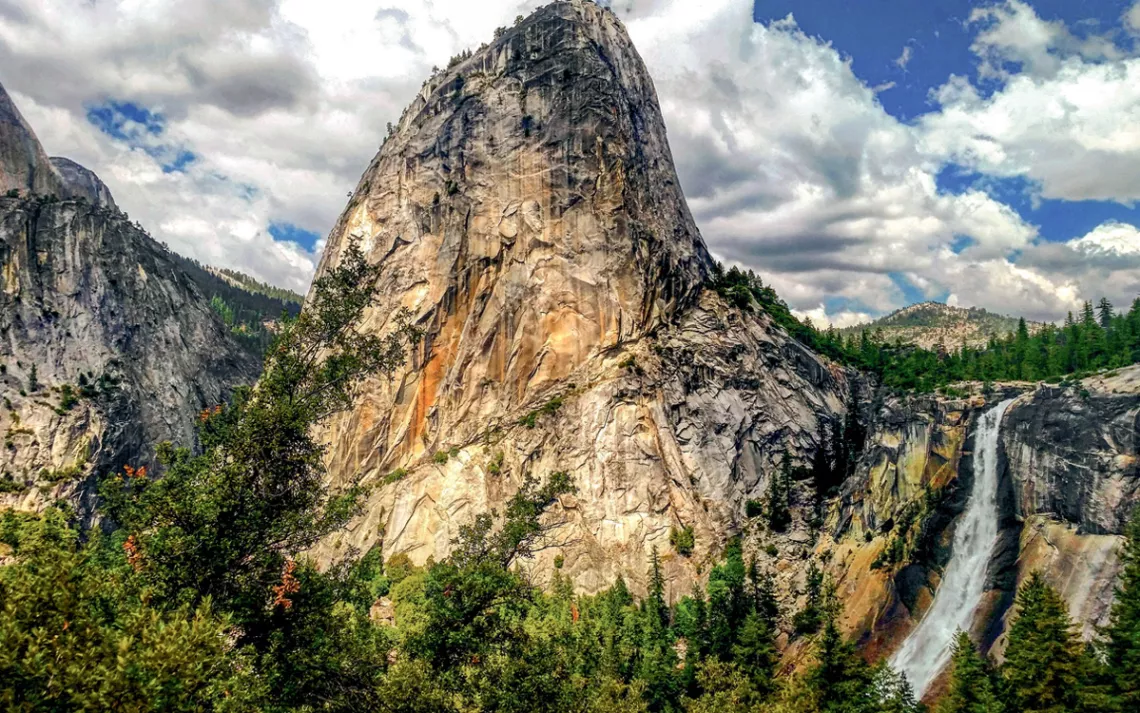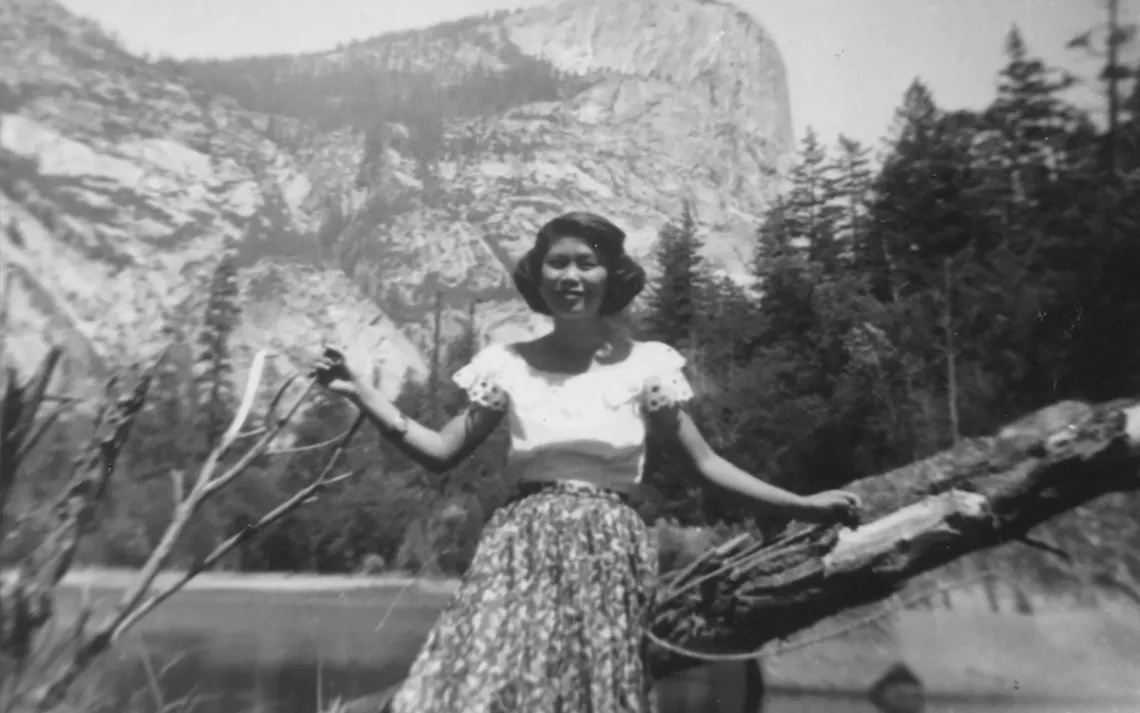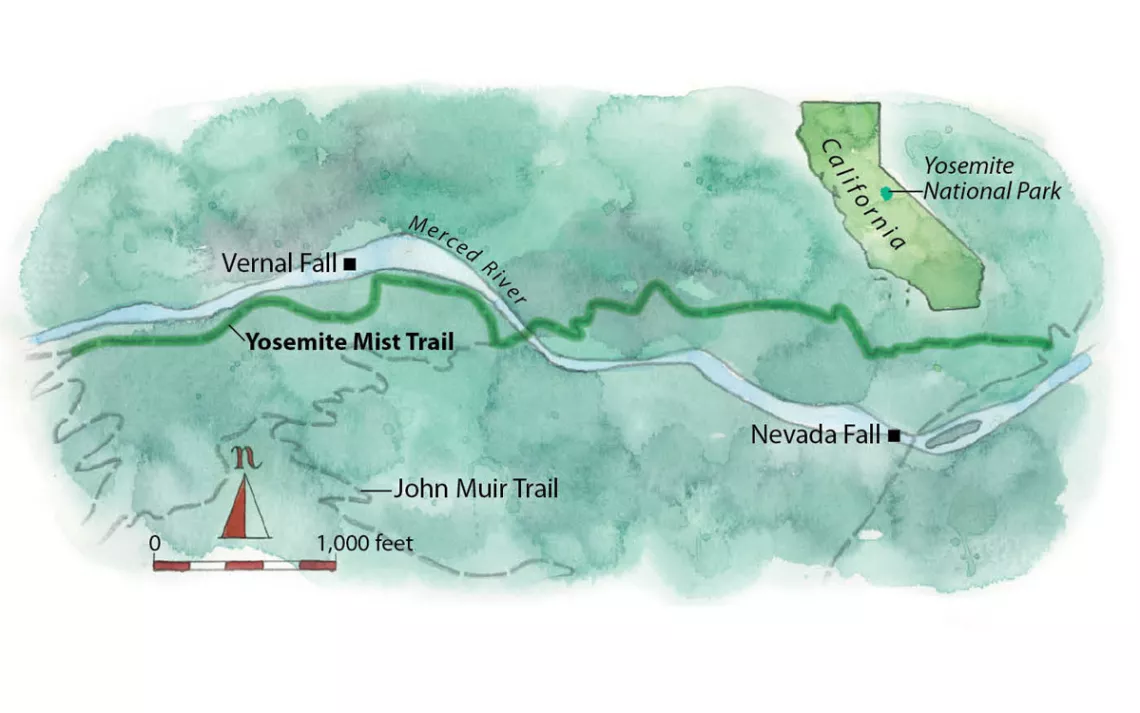Explore Yosemite's Mist Trail—and the Park's Chinese American Legacy
Inside one writer's quest to unearth family history within "Gold Mountain"

Nevada Fall, Yosemite National Park | Photo by Brian Bennett/EyeEm/Getty Images
A 1950s PHOTOGRAPH IN A DUSTY FAMILY ALBUM reveals who my father once was. He's gazing into an August sky, his black hair swept back, Hawaiian shirt and slacks on his slim, 23-year-old frame. He poses before a redwood and beside his new bride, then 17 and just about fresh off the boat from Hong Kong.
"Yosemite," my mother told me when I was about six. "Our honeymoon." My father's father, then the unofficial mayor of Los Angeles' Chinatown, had splurged for one night at the Ahwahnee, where my parents dined in the grand hotel's candlelit hall: roast chicken and potatoes for her; filet mignon, served rare, for my dad.
What truly reveals my father in the photo is his face—beaming pure, rare happiness, before the pressures from failed business dreams and eight mouths to feed wore it down. Here, among the granite gods of the valley, he was an amateur geologist, a homegrown botanist sleuthing down sequoias—a proud American, no qualifier needed. Away from L.A.'s inner city, my father experienced none of the usual racial taunts—China Boy! Go back to where you came from! He could move freely among the shimmering lakes and towering pines, communing with what he loved most.

Ann Gee, on her honeymoon in Yosemite National Park | Photo Courtesy of Alison Singh Gee
As often as we could afford it as the years went by, my father—Ba, as we called him—rented a rickety cabin in Yosemite Valley. We'd wake and set out to conquer waterfalls, visit the ranger station for bear talks and homemade date-nut bread, and bike in the shadow of Half Dome. Ba hiked us past monuments, regaling us with the tales of John Muir, the Donner Party, and Ansel Adams.
On one trip, Ba led us to Vernal and Nevada Falls. But within minutes of setting out, he sent me back down to my mother, waiting on the footbridge below. "You're not strong enough for this," he said. Hours after scrambling up the small, steep path, my siblings returned, all flushed cheeks and beaming accomplishment. "It was great!" my little brother shouted. "Too bad you couldn't come." From that day forward, the trail lived on in my mind as the granite behemoth I would one day conquer.
That night, Ba grilled chicken legs slathered in hoisin sauce and lap cheong, Chinese sausage. We never said it, but it was something we all felt in our bones: Yosemite accepted us for who we were. With our banged-up station wagon and strange-smelling grill foods, we were a raggedy clan of Chinese Americans claiming this Californian dreamland as our own. Until my father died in 1999, he kept a portrait of Half Dome on the wall—a reminder, perhaps, that a perfect world did exist, only six hours away.
Of course, we weren't the first Chinese Americans to discover Yosemite. A few years back, park ranger Yenyen Chan stumbled across a 19th-century photograph of Cantonese laborers. The workmen had been drawn to the West—Gold Mountain, they called it in Canton Province—by the promise of mineral riches. In this often-hostile new land, some 250 of them found arduous work building roads to Yosemite during the winter, when blizzards pummeled the mountains.

Map by Steve Stankiewicz
Every year, Ranger Chan leads a group up to Sing Peak, named after another Chinese immigrant who, when the gold ran out, sought employment in Yosemite's kitchen. Tie Sing cooked delicious steaks and fish and cowboy coffee for the Mather Mountain Parties—groups of powerful industrialists and politicians invited on luxurious camping trips by the first director of the National Park Service, Stephen Mather. The Mather men christened Sing the "gourmet chef of the Sierra."
While I haven't made it to the peak named for the affable cook—who ultimately gave his life to Yosemite, dying during a cooking accident—my family and I continue to frequent Ba's favorite park. When my daughter Anais was three, my husband and I led her up the steep Mist Trail to my old nemeses: Vernal and Nevada Falls. "You can do this!" I cheered.
But of course, I was also willing myself. The three of us bounded up the trail's slick stone steps, but halfway up, my knees started to ache, and I had to rest. "Go on without me." My family disappeared into the mist and up the mountain, and I sat, resigned and unhappy. Thirty-five years later, the trail had beaten me again. Eventually, I forced myself back onto the steps. I found my husband and daughter an hour later, cooling their feet in the sparkling pool between Vernal Fall and Nevada Fall up above. Unlacing my boots, I turned my face to the sky and, before splashing in the brisk snowmelt, said, "This one's for you, Ba."
It was my father who built my road to Yosemite. Today, when I bring my family to the park, we thank not only Ba but also the Chinese immigrants who labored over the roads, and Tie Sing, whose passion for the park inspired men to preserve it. This summer, we'll return to summit Sing Peak. No doubt, my father's beloved Half Dome will be standing, imperfect and luminous, somewhere in the middle distance.
This article appeared in the March/April 2018 edition with the headline "Return to Gold Mountain."
Take a Sierra Club trip to Yosemite. Details at sierraclub.org/adventure-travel.
MORE
Learn more about Tie Sing and other Chinese Americans who helped cement Yosemite's legacy as a crown jewel of the national park system: sc.org/tiesing.
- WHERE Mist Trail, Yosemite National Park, California
- GETTING THERE The popular Mist Trail begins near Happy Isles, at the southeastern end of Yosemite Valley. To avoid traffic, take the park shuttle bus and get off at stop 16. The round-trip hike to the top of Vernal Fall is 2.4 miles, with a 1,000-foot elevation gain. To get to the top of Nevada Fall, 2,000 feet higher, you have to hike another three miles round-trip.
- WHEN TO VISIT The trail is open year-round, but the falls are at their peak during spring and early summer. Come winter, the trail can be icy and slick.
- WHERE TO STAY You can't beat the Majestic Yosemite Hotel (formerly the Ahwahnee Hotel), on the valley floor, for old-world graciousness. The Yosemite Valley Lodge, just a few minutes' drive away, is a comfortable, rustic option, and Housekeeping Camp offers family-friendly and affordable lodging.
- WHERE TO EAT The Mountain Room at Yosemite Valley Lodge offers excellent steaks, seafood, and pasta in a modern chalet atmosphere.
- ADDITIONAL READING For more on Tie Sing, check out the picture book Mountain Chef (Charlesbridge, 2016).
 The Magazine of The Sierra Club
The Magazine of The Sierra Club



